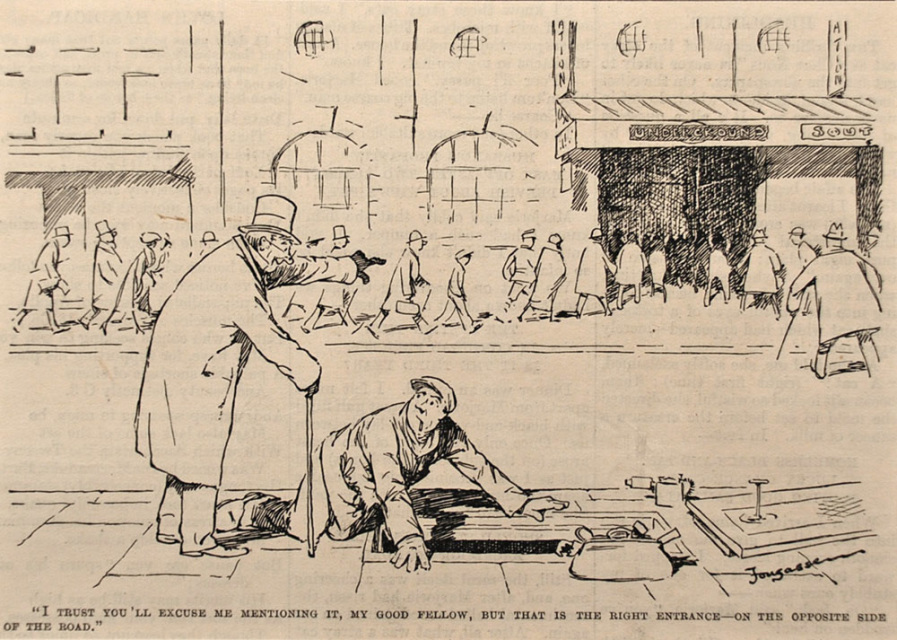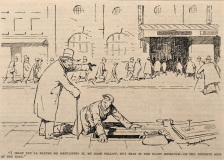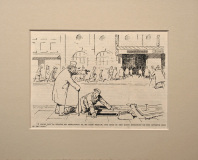- Decorative
- >
- Punch Cartoons
- >
- Entering the Underground, 1920
Entering the Underground, 1920
SKU:
20P52
£17.99
£17.99
Unavailable
per item
Fougasse - Cyril Kenneth Bird (1887-1965)
Cartoon taken from a disbound copy of the Punch Almanack, 1920
In a cream conservation grade mount (matt)
In very good condition, as illustrated
Cartoon: 12.4 x 17.6 cm (visible); mount: 20.4 x 25.4 cm (8" x 10")
Visit our Frames page to view and select a frame for this work
Free delivery within the UK (we dispatch worldwide, too)
1 available
Cyril Kenneth Bird – Fougasse (1887-1965)
Bird’s first illustrations appeared in Punch in 1916 after he was invalided out of the First World War as a result of a gunshot to the spine at Gallipoli. As a cartoonist, he used the name ‘Fougasse’ – a small antipersonnel mine in the war – to avoid confusion with fellow Punch cartoonist W Bird (W Bird was itself a pseudonym used by the Irish artist Jack Butler Yeats). Bird’s association with Punch was long and important. He was made Art Editor in 1937 and Editor in 1949 (the only cartoonist ever to hold the post). Away from the magazine, Bird is remembered for the ‘Careless Talk Costs Lives’ posters he produced for the Ministry of Information during the Second World War.
Price (1957), in discussing the development of Bird’s style, wrote, ‘Clarity and speed were everything in his work and he was constantly trying to simplify. He began fairly close to the orthodox illustrator of the humours of life like Bert Thomas; but he rapidly developed a personal style that was perhaps the first introduction of contemporary advertising techniques to the editorial pages of Punch… In early Fougasse a tree would be in a drawing for itself, for the opportunity it provided for filling the whole rectangle with a pleasing design. Later the tree would be there only if strictly needed to make a point, and then it would be an ideological tree, not woody, leafy and alive. He relied on the reader’s imagination, whereas the illustrators felt themselves bound to do all the work for the reader. Fougasse led the way to aiming at an active rather than a passive readership. Like [George] Morrow, he was primarily a humourist. His jokes were better than other people’s.’
Collections
Imperial War Museum
Tate Britain
Victoria and Albert Museum
Sources and further reading
Bryant M and Heneage S (1994), Dictionary of British Cartoonists and Caricaturists 1730-1980, Scolar Press
Dolman B (1981), A Dictionary of British Artists, 1929, Antique Collectors’ Club
Johnson J and Greutzner A (1999), British Artists 1880-1940, Antique Collectors’ Club
Price R G G (1957), A History of Punch, Collins
Waters G M (1975), Dictionary of British Artists 1900-1950, Eastbourne Fine Art
Bird’s first illustrations appeared in Punch in 1916 after he was invalided out of the First World War as a result of a gunshot to the spine at Gallipoli. As a cartoonist, he used the name ‘Fougasse’ – a small antipersonnel mine in the war – to avoid confusion with fellow Punch cartoonist W Bird (W Bird was itself a pseudonym used by the Irish artist Jack Butler Yeats). Bird’s association with Punch was long and important. He was made Art Editor in 1937 and Editor in 1949 (the only cartoonist ever to hold the post). Away from the magazine, Bird is remembered for the ‘Careless Talk Costs Lives’ posters he produced for the Ministry of Information during the Second World War.
Price (1957), in discussing the development of Bird’s style, wrote, ‘Clarity and speed were everything in his work and he was constantly trying to simplify. He began fairly close to the orthodox illustrator of the humours of life like Bert Thomas; but he rapidly developed a personal style that was perhaps the first introduction of contemporary advertising techniques to the editorial pages of Punch… In early Fougasse a tree would be in a drawing for itself, for the opportunity it provided for filling the whole rectangle with a pleasing design. Later the tree would be there only if strictly needed to make a point, and then it would be an ideological tree, not woody, leafy and alive. He relied on the reader’s imagination, whereas the illustrators felt themselves bound to do all the work for the reader. Fougasse led the way to aiming at an active rather than a passive readership. Like [George] Morrow, he was primarily a humourist. His jokes were better than other people’s.’
Collections
Imperial War Museum
Tate Britain
Victoria and Albert Museum
Sources and further reading
Bryant M and Heneage S (1994), Dictionary of British Cartoonists and Caricaturists 1730-1980, Scolar Press
Dolman B (1981), A Dictionary of British Artists, 1929, Antique Collectors’ Club
Johnson J and Greutzner A (1999), British Artists 1880-1940, Antique Collectors’ Club
Price R G G (1957), A History of Punch, Collins
Waters G M (1975), Dictionary of British Artists 1900-1950, Eastbourne Fine Art



